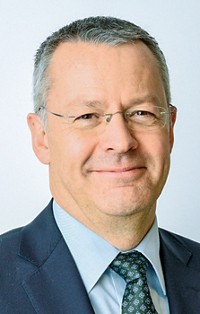Advertisement
Grab your lab coat. Let's get started
Welcome!
Welcome!
Create an account below to get 6 C&EN articles per month, receive newsletters and more - all free.
It seems this is your first time logging in online. Please enter the following information to continue.
As an ACS member you automatically get access to this site. All we need is few more details to create your reading experience.
Not you? Sign in with a different account.
Not you? Sign in with a different account.
ERROR 1
ERROR 1
ERROR 2
ERROR 2
ERROR 2
ERROR 2
ERROR 2
Password and Confirm password must match.
If you have an ACS member number, please enter it here so we can link this account to your membership. (optional)
ERROR 2
ACS values your privacy. By submitting your information, you are gaining access to C&EN and subscribing to our weekly newsletter. We use the information you provide to make your reading experience better, and we will never sell your data to third party members.
Business
Reviving W.R. Grace
CEO Fred Festa prepares Grace for the day when bankruptcy ends
by Marc S. Reisch
March 6, 2006
| A version of this story appeared in
Volume 84, Issue 10
Over the past year-and-a-half, W.R. Grace's stock has been on a roller-coaster ride. Each time Congress appeared to make progress on legislation that would take asbestos litigation out of the courts, Grace's price rose. When the legislation hit a roadblock, Grace's price fell. But to Fred Festa, 46, president and chief executive officer, gyrations in Grace's stock price, which ranged from $6.67 to $14.02 during 2005, are of less concern than "protecting and growing" Grace's businesses.
Grace filed for bankruptcy reorganization in 2001. At the time, the company had already paid out $1.9 billion to manage and resolve asbestos litigation but still faced 129,000 asbestos personal injury claims.
The legislation, stalled once again, is known as the Fairness in Asbestos Injury Resolution Act. It would set up a $140 billion fund to be financed by a huge number of firms, including Grace, that once manufactured asbestos-containing products. Claimants with lung diseases linked to asbestos would be compensated from the fund. Grace executives acknowledge that their firm would probably pay less into the federal fund than it would through the trust fund for victims that is envisioned in its reorganization plan.
No matter what, Grace now has "an opportunity to come out of bankruptcy and be very successful," Festa says. "We'll let the bankruptcy court decide" how much of the pie goes to asbestos claimants and others, including creditors and shareowners.
As it stands now, the reorganization plan, filed in 2004 and amended in 2005, puts Grace's asbestos liabilities at $1.7 billion. It would pay off unsecured creditors in full and give current Grace shareholders 50% ownership in the post-bankruptcy firm. Paul J. Norris, 58, who gave up the CEO spot to Festa in June 2005 and remains Grace's chairman, is focusing his efforts on extricating Grace from bankruptcy.
The firm has been profitable even during bankruptcy. Operating income, excluding unusual items, in 2005 rose more than 40% to $141 million, compared with the year earlier, on a 14% sales increase to $2.6 billion. "We've maintained R&D spending and we've put money into the pension plan," Festa says. "That's a credit to our good financial position. Whoever will own Grace will own a healthy company."
Festa ought to know how to gauge a company's health. He has a B.S. in finance from the State University of New York, Oswego, and before joining Grace as president and chief operating officer at the end of 2003, he was a partner at Morgenthaler Private Equity, an $850 million buyout firm.
In the 1990s while at AlliedSignal, which has since merged into Honeywell, Festa was vice president and general manager of chemical intermediates, where he arranged the sale of a phenol business to Sunoco. His tenure at AlliedSignal overlapped that of Norris, who at one time was an Allied senior vice president.
Festa says he decided to leave Morgenthaler because "I'm a tinkerer. I like to play with operations." At Morgenthaler, he would have played a supervisory rather than an active role in businesses the firm acquired. Grace offered him a challenge.
"Yes," Festa admits, "Grace has a legacy and a shadow following it around." Aside from asbestos liabilities, Grace is financing cleanup at a former vermiculite mine in Libby, Mont. In addition, last year a federal indictment charged that the firm and a number of its executives knew the mine was releasing asbestos into the surrounding community. "But through the bankruptcy process, I have a chance to lead this company back to prominence. It is that simple and that complex," he says.
Looking ahead to the day when Grace emerges from bankruptcy, Festa says Grace could "add a third piece" to the firm's two main businesses: Davison, which makes silica and alumina catalysts, and performance chemicals, which includes construction chemicals and food container sealant systems. "I think that we can be a consolidator coming out of bankruptcy," he says. "A $1 billion or $2 billion chemical segment could fit nicely with Grace's existing businesses."
Few if any analysts cover Grace because it is still under court supervision. While analyst John Robers of Buckingham Research doesn't cover Grace, he does keep an eye on the firm and suggests that Grace could, like Dow Corning, emerge strong and grow after bankruptcy. Then again, "scrubbed clean" of environmental and other obligations, Grace could itself be a takeover target, he says.
Festa acknowledges that Grace could become part of another organization. But most of all he would like to see the firm survive and capitalize on Grace's proven ability to manipulate molecules. To make the firm stronger, Grace would seek a business that "is contrary to our current business cycles," which are dependent on the rise and fall in energy demand and construction.
He would, for instance, consider a deal in the life sciences, where Grace has cultivated a small business in silica-containing products for chromatography columns. In fact, Festa points out, 12 of the 22 acquisitions Grace has completed since it entered Chapter 11 have been in the life sciences. They include Grom Analytik + HPLC GmbH, a German provider of column packings for small-molecule separations, and Alltech International, a manufacturer of chromatography products.
Other purchases by Grace include Single-Site Catalysts, a supplier of organometallic catalysts for polyolefins and elastomers.
But operating under court supervision has constrained the firm's ability to make sizable acquisitions. The 22 deals have been small bolt-on operations that collectively have added only $200 million in revenue since Grace entered bankruptcy.
After bankruptcy, though, Festa says Grace could borrow up to $900 million to build another large business. "Our cash flow can support that debt," he asserts. "It's affordable and gives us the flexibility to add another leg."
Festa points out that Grace has also generated new sales in its existing businesses since 2001. "About 80% of our growth has been organic," he says. For example, in the construction chemicals business, Grace has staked a claim in the fast-growing Chinese market with admixtures aimed at improving concrete handling, strength, performance, and durability. Last September, Grace opened a cement additives technical center in Shanghai, its third such center in that country.
Though about 60% of Grace's sales come from outside North America, the firm continues to invest in its home market. It just announced plans to spend $20 million on a new facility in Mount Pleasant, Tenn., for roofing, flashing, and structural waterproofing materials, including Grace Ice & Water Shield.
Festa wants to boost R&D spending to further increase returns from in-house technology. Grace has budgeted a 20% increase in R&D in 2006 to about $70 million, and Festa says he hopes to increase spending as a percentage of sales from 2.4% of sales in 2005 to 3.5% in 2008. "I'm a huge believer in technology," he says.

William A. Welsh and Felek Jachimowicz, vice presidents of research for the Davison and performance chemicals businesses, respectively, say they are happy to get the additional resources. Between them, they supervise about 400 R&D and technical service personnel. Grace, which already gets about 20% of sales from brand- new products introduced over the past five years, should be able to improve on that rate of return, the two say.
Welsh, who has a Ph.D. in inorganic chemistry from the University of Delaware, says he'll direct a large part of the increase in research resources to programs and "incubator technologies" that are new to Davison. Many of the new forward-looking projects will involve academic researchers, Welsh adds.
Since most growth in performance chemicals is outside of North America, Jachimowicz says much of his increase in R&D spending will go to Asia and Europe. Jachimowicz, who has a Ph.D. in physical organic chemistry from the University of Basel, in Switzerland, will also be taking a few more chances than he would have before. His group will "invest more in step-change technology that would allow for significant differentiation from competitors' products. We want to put more emphasis on longer term, higher risk projects where the payoff would be greater," he says.
In keeping with Festa's emphasis on R&D, the two scientists have formed the Grace Research Council to talk over issues common to their respective undertakings. In addition to Welsh and Jachimowicz, the council includes the presidents of the two Grace divisions and directors of Grace labs scattered across the world.
The 15 people in the group meet quarterly to exchange best practices, decide on strategic directions, and standardize procedures. "On a technical level, people in the two technical organizations always talked to one another," Welsh explains. "But it was more difficult to cooperate because of our organization. Festa has facilitated information sharing."
Festa says: "You can be a winner when you break down the traditional paradigms. My leadership team has the culture to do that. We've got to get through the Chapter 11 issue, and then, I think, we will be a consolidator. I think we will be a leader in specialty chemicals and materials going forward."







Join the conversation
Contact the reporter
Submit a Letter to the Editor for publication
Engage with us on Twitter